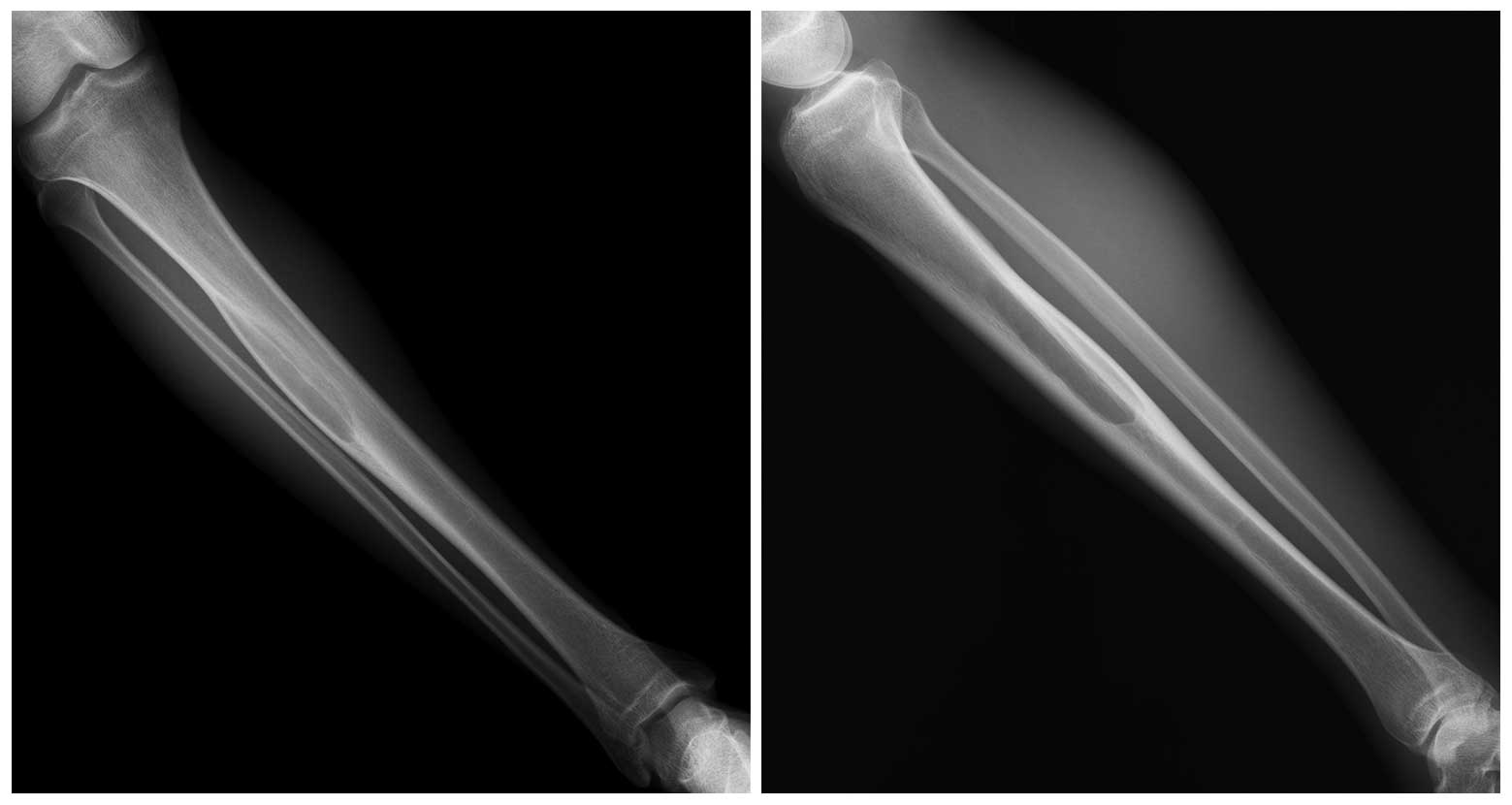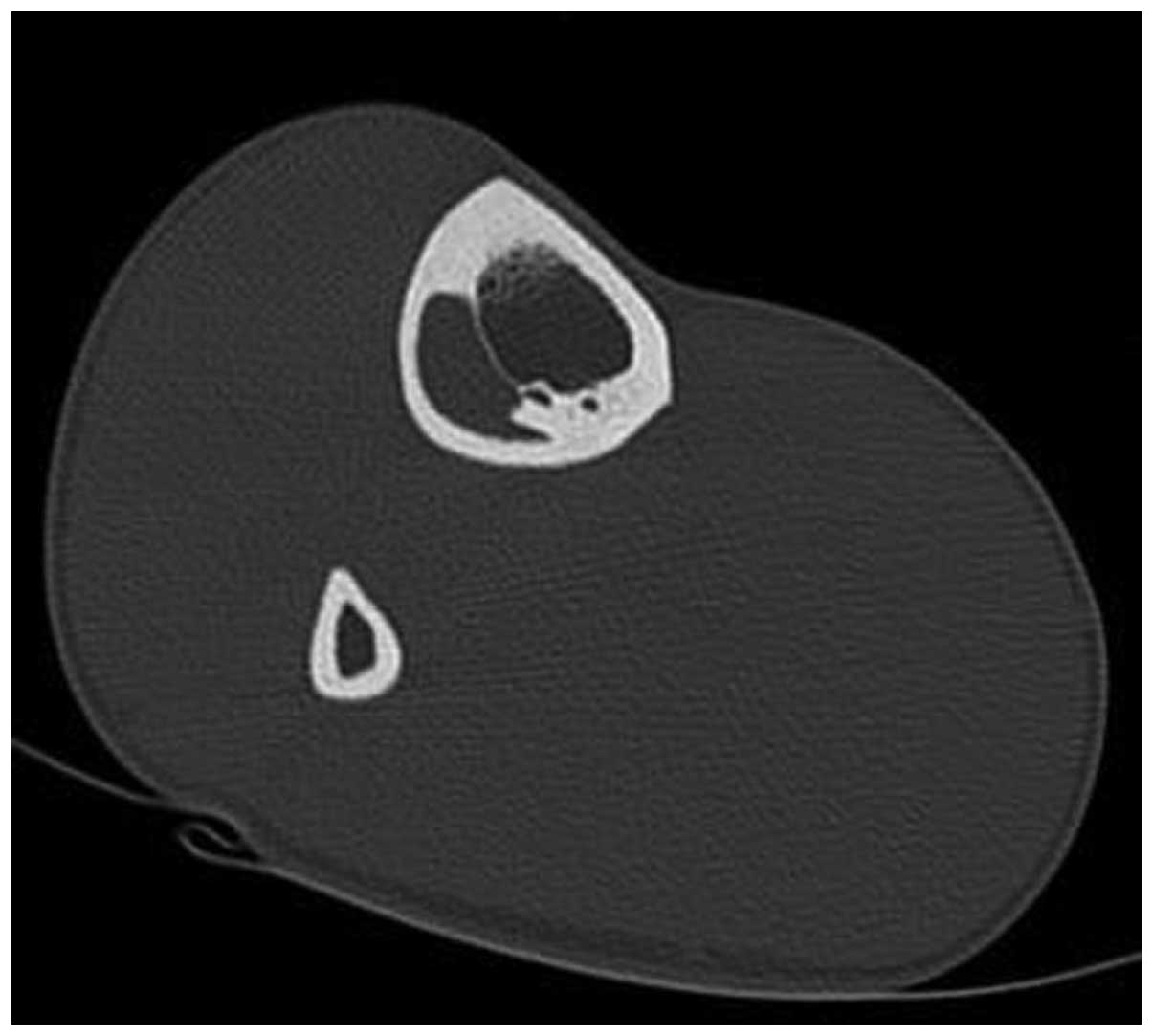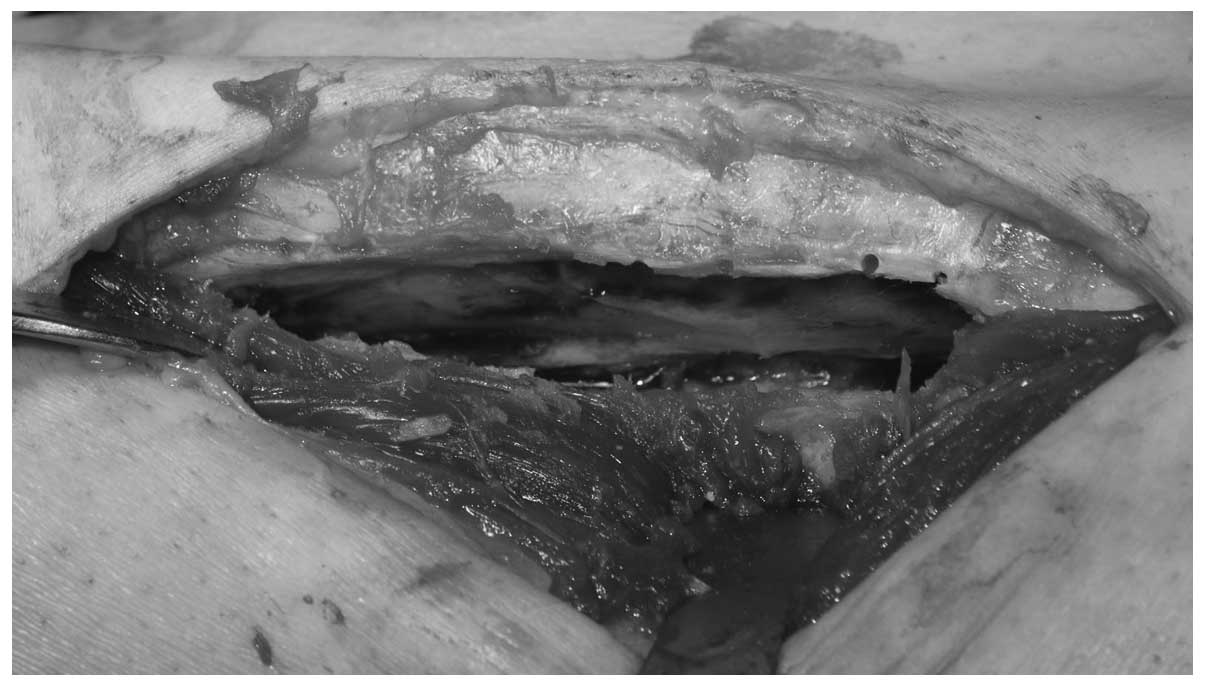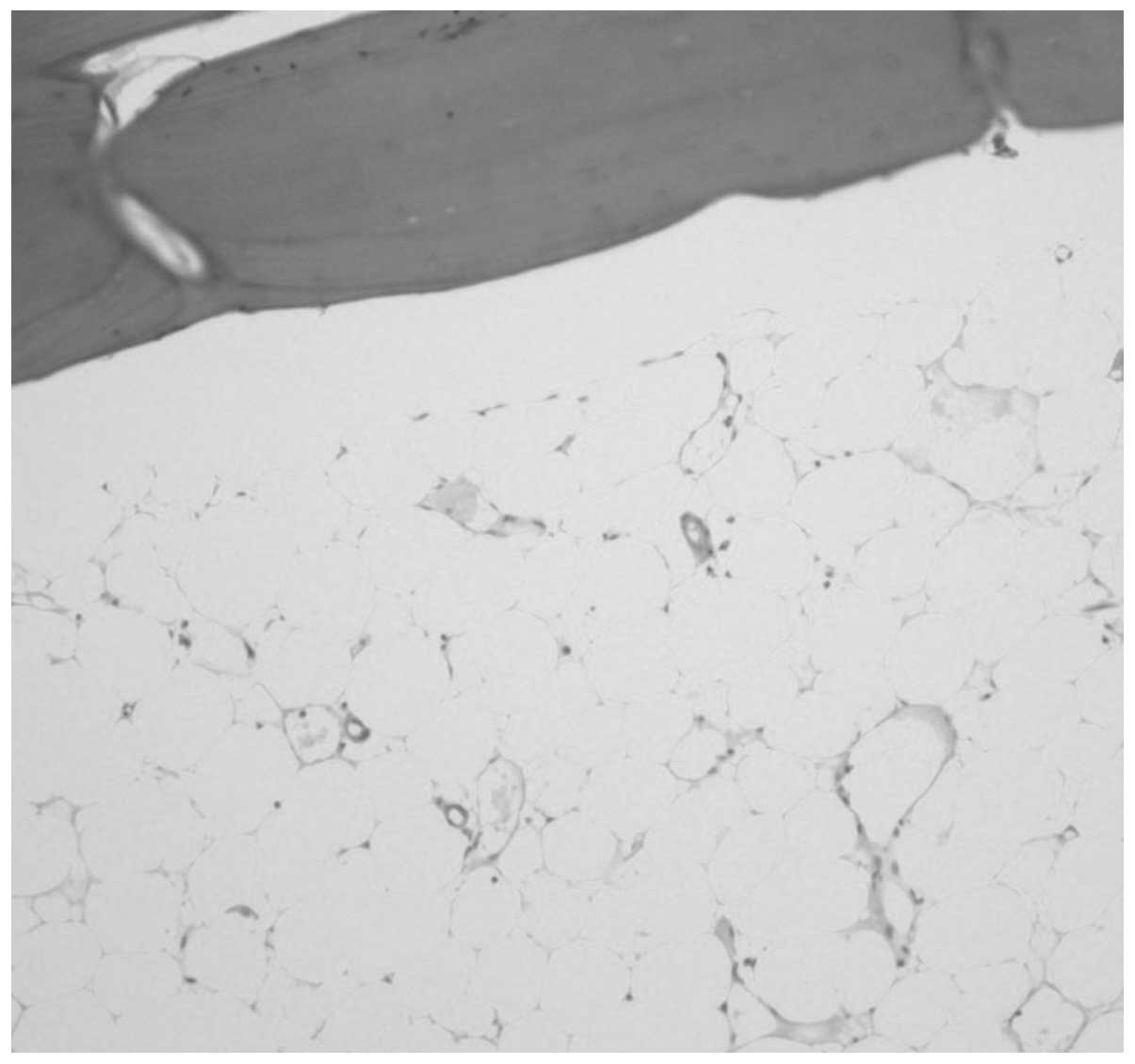First case report of an intracortical lipoma in an adult tibia
- Authors:
- Published online on: November 12, 2013 https://doi.org/10.3892/ol.2013.1682
- Pages: 223-226
Abstract
Introduction
Intraosseous lipoma represents a relatively rare lesion composed of mature adipose tissue. The true incidence remains unknown, as the majority of lesions are asymptomatic and do not require medical attention. A number of authors have characterized these lesions as benign tumors of the medullary fat tissue (1,2). However, there have been four published cases of intracortical lipoma (3–6). To the best of our knowledge, intracortical lipoma in an adult tibia has not been previously described. The current case report describes an adult patient with symptomatic intracortical lipoma in the tibial diaphysis. The study was approved by the ethics committee of Chung-Ang University (Seoul, Korea). Written informed consent was obtained from the patient’s family.
Case report
A 23-year-old male presented to the Department of Orthopedic Surgery (College of Medicine, Chung-Ang University, Seoul) with pain and discomfort on the lateral aspect of the tibia. The patient denied history of trauma and had no past medical history. On physical examination, no visible or palpable mass, erythema, or warmth were noted. However, there was mild local tenderness on the lateral side of the tibia. Radiographs showed a well-defined osteolytic lesion in the tibial diaphysis with bulging on the posterolateral side. Plain radiographs did not show any evidence of periosteal reaction or cortical destruction (Fig. 1), however, confinement of the lesion to the cortex could not be confirmed. Computed-tomography (CT) scanning revealed a lucent lesion with regular margins, which did not involve the medullary cavity. The lesion was well-circumscribed and surrounded by sclerotic bone. The measurements were 90 mm in length and 20×10 mm in maximum diameter (Fig. 2). Magnetic resonance imaging (MRI) revealed that the lesion consisted of two different components, a central portion with low-signal intensity on T1-weighted MRI and high-signal intensity on T2-weighted MRI, and a peripheral portion with high-signal intensity on T1-weighted and T2-weighted MRI (Fig. 3). Technetium-99m scintigraphic scanning revealed increased isotope uptake at the lesion site. Based on the collective findings, the radiologist raised the possibility of an intracortical lipoma.
Excisional biopsy was performed to clarify the diagnosis. Following an incision on the anterolateral skin, periosteal dissection of the anterior compartment muscles was completed. The lesion was then identified to be bulging laterally and the surrounding cortical bone was removed. Macroscopically, the lesion showed cystic changes and was composed of fat tissue. Curettage was performed and the true cortex was located beneath the lesion (Fig. 4). Histopathological examination of the resected and curettage samples showed mature adipocytes with trabecular bone. No cellular atypia, fat necrosis or calcifications were observed (Fig. 5). Pain and discomfort disappeared during the postoperative period, and no tumor recurrence was observed at the 12-month postoperative follow-up.
Discussion
Intraosseous lipoma is a rare, benign bone tumor that accounts for <0.1% of primary bone tumors (7). Differential diagnosis includes non-ossifying fibroma, simple bone cyst, fibrous dysplasia, enchondroma, aneurismal bone cyst, bone infarct and osteomyelitis (1,8–10). This particular tumor occurs most frequently in the lower limb, particularly in the calcaneus. Other common sites include long bone metaphyses (11). The majority of lesions are located intramedullary, and cortical bone involvement is rare. According to published reports, four cases of intracortical lipoma have been previously described. Of these cases, three patients were adults and all tumors were located in the femoral diaphysis (3,4,6). The remaining case report was of a seven-year-old pediatric patient with a tumor located in the tibial metaphysis (5). All four patients were female, two patients presented with pain and two lesions were found incidentally. The present case study appears to be the first report of an adult patient with an intracortical lipoma in the tibial diaphysis (Table I).
Radiographic appearance of intraosseus lipomas varies but can include well-defined osteolytic lesions with marginal sclerosis. Radionuclide bone scanning can be positive or negative and, therefore, has limited diagnostic utility (12). Although diagnosis of intracortical lipoma on plain radiographs remains challenging, CT and MRI are useful for detecting fat within the lesion and for helping to confirm a purely intracortical location (7). Lipoma fat can be easily recognized on MRI by high-signal intensity on T1- and T2-weighted images. Cyst signal intensity is low on T1-weighted MRI but high on T2-weighted MRI due to the fluid component. In the present patient, peripheral high-signal density on T1- and T2-weighted MRI scans was captured due to fat tissue. The central portion of the cystic change showed low-signal intensity on T1-weighted MRI and high-signal intensity on T2-weighted MRI. In operation filed, we could confirm that the radiological finding corresponded to the pathologic specimen.
Previously, Milgram (8) subdivided intraosseous lipomas into three stages. Stage 1 lesions are purely radiolucent and consist almost entirely of fat tissue. In stage 2 lesions, central calcifications with adjacent minor cystic degeneration in viable adipocytes are observed. Stage 3 lesions represent late cases in which fat has been devitalized with varying degrees of cyst formation, calcification and reactive bone formation. Although there were no calcific changes, we hypothesize that the histological observations of the current case are consistent with stage 3 lesions, due to the appearance of cystic changes.
The pathogenesis of intracortical lipomas remains controversial. A number of authors have suggested that lesions represent benign tumors of medullary adipose tissue (1,2). Others consider these lesions to be products of reactive changes secondary to infarct, infection or trauma (13). It has also been proposed that cyst formation results from degeneration of a pre-existing lipoma, or that a lipoma represents the late-stage of a simple bone cyst (11). However, none of the aforementioned theories adequately explain the underlying pathogenesis of an intracortical lipoma.
The majority of intraosseous lipomas can be managed conservatively. Surgery is indicated for symptomatic lesions, malignancy, or risk of pathological fracture. Surgical treatment usually consists of curettage and bone grafting (11). For the current case, surgical treatment was performed, as the lesion was large and the patient complained of mild pain. Furthermore, confirmation that the lesion was a benign, intracortical lipoma was not obtained.
In conclusion, the current report presents a case of an adult male with an intracortical lipoma accompanied by cystic changes in the tibial diaphysis. Intracortical lipoma represents a rare, benign bone tumor typically discovered incidentally. Although biopsy is required to confirm diagnosis, CT and MRI are useful imaging modalities to elucidate lesion characteristics and location. Intracortical lipomas should be included in the differential diagnosis of intracortical, osteolytic lesions of long bones.
Acknowledgements
This study was supported by a grant from the Basic Science Research Program through the National Research Foundation of Korea funded by the Ministry of Education, Science and Technology (2013R1A1A2007989).
References
|
Barcelo M, Pathria MN and Abdul-Karim FW: Intraosseous lipoma. A clinicopathologic study of four cases. Arch Pathol Lab Med. 116:947–950. 1992.PubMed/NCBI | |
|
Chow LT and Lee KC: Intraosseous lipoma. A clinicopathologic study of nine cases. Am J Surg Pathol. 16:401–410. 1992. View Article : Google Scholar : PubMed/NCBI | |
|
Downey EF Jr, Brower AC and Holt RB: Case report 243. Cortical ossifying lipoma of femur. Skeletal Radiol. 10:189–191. 1983.PubMed/NCBI | |
|
Lee SJ, Yoon JH, Bae JI, et al: Intracortical lipoma of the femur. Skeletal Radiol. 36:S77–S81. 2007. View Article : Google Scholar | |
|
Madhuri V, Manipadam MT, Walter NM and Cherian RA: Intracortical lipoma of bone: report of the first case in a child. J Pediatr Orthop B. 16:327–329. 2007. View Article : Google Scholar : PubMed/NCBI | |
|
Yamamoto T, Marui T, Akisue T, et al: Intracortical lipoma of the femur. Am J Surg Pathol. 26:804–808. 2002. View Article : Google Scholar : PubMed/NCBI | |
|
Eyzaguirre E, Liqiang W, Karla GM, Rajendra K, Alberto A and Gatalica Z: Intraosseous lipoma. A clinical, radiologic, and pathologic study of 5 cases. Ann Diagn Pathol. 11:320–325. 2007. View Article : Google Scholar : PubMed/NCBI | |
|
Milgram JW: Intraosseous lipomas. A clinicopathologic study of 66 cases. Clin Orthop Relat Res. 277–302. 1988.PubMed/NCBI | |
|
Lauf E, Mullen BR, Ragsdale BD and Kanat IO: Intraosseous lipoma of distal fibula. Biomechanical considerations for successful treatment. J Am Podiatry Assoc. 74:434–440. 1984. View Article : Google Scholar | |
|
Appenzeller J and Weitzner S: Intraosseous lipoma of os calcis. Case report and review of literature of intraosseous lipoma of extremities. Clin Orthop Relat Res. 171–175. 1974.PubMed/NCBI | |
|
Campbell RS, Grainger AJ, Mangham DC, Beggs I, Teh J and Davies AM: Intraosseous lipoma: report of 35 new cases and a review of the literature. Skeletal Radiol. 32:209–222. 2003. View Article : Google Scholar : PubMed/NCBI | |
|
Murphey MD, Carroll JF, Flemming DJ, Pope TL, Gannon FH and Kransdorf MJ: From the archives of the AFIP: benign musculoskeletal lipomatous lesions. Radiographics. 24:1433–1466. 2004. View Article : Google Scholar : PubMed/NCBI | |
|
Barker GR and Sloan P: Intraosseous lipomas: clinical features of a mandibular case with possible aetiology. Br J Oral Maxillofac Surg. 24:459–463. 1986. View Article : Google Scholar |














